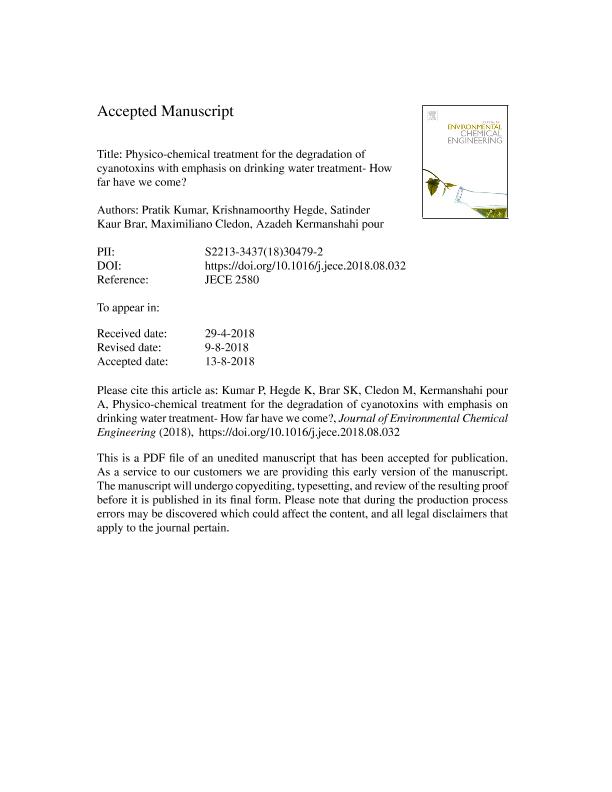Mostrar el registro sencillo del ítem
dc.contributor.author
Kumar, Pratik
dc.contributor.author
Hegde, Krishnamoorthy
dc.contributor.author
Brar, Satinder Kaur

dc.contributor.author
Cledón, Maximiliano

dc.contributor.author
Kermanshahi Pour, Azadeh
dc.date.available
2020-11-10T18:09:32Z
dc.date.issued
2018-08
dc.identifier.citation
Kumar, Pratik; Hegde, Krishnamoorthy; Brar, Satinder Kaur; Cledón, Maximiliano; Kermanshahi Pour, Azadeh; Physico-chemical treatment for the degradation of cyanotoxins with emphasis on drinking water treatment - How far have we come?; Elsevier; Journal of Environmental Chemical Engineering; 6; 4; 8-2018; 5369-5388
dc.identifier.issn
2213-3437
dc.identifier.uri
http://hdl.handle.net/11336/118081
dc.description.abstract
Over the years, various physicochemical treatment processes, such as photocatalysis, membrane technology, ozonolysis and chlorination have been tested at laboratory and pilot scale for the treatment of various cyanotoxins. Most of these treatment processes are also being commonly practiced in a drinking water treatment plants (DWTPs). However, the degree of treatment widely varies among cyanotoxin variants and is mainly governed by the source water characteristics, operational parameters (temperature, pH, cyanotoxin level) which changes continuously in a DWTPs. Other common elements present in raw water, such as natural organic matter (NOMs), residual nutrients and metal ions shows competitive behaviour with the cyanotoxins. Thus, a high demand in input energy is needed for unit operations, such as photocatalysis, reverse osmosis membrane and excess chemical requirement in terms of ozone, permanganate and chlorine (for ozonation and chlorination) which can breach the guidelines and increase the toxicity level. This review provides an insight into the effectiveness of major physico-chemical operations from simple to the advanced treatment level for the removal of different cyanotoxins along with their limitations and challenges in a DWTP. The goal of this review is to provide information on the possible reaction mechanism involved in the cyanotoxin treatment, accounting mainly for the toxicity, modifications in the process that happened over the years and the process feasibility. In future, hybrid technique assisted by UV, peroxides, among others promises to assist photocatalytic, ozonation and chlorination to undergo efficient cyanotoxin removal with reduced toxicity level. Also, persistence cyanotoxins, such as anatoxin and saxitoxin need further study.
dc.format
application/pdf
dc.language.iso
eng
dc.publisher
Elsevier

dc.rights
info:eu-repo/semantics/openAccess
dc.rights.uri
https://creativecommons.org/licenses/by-nc-sa/2.5/ar/
dc.subject
PHYSICO-CHEMICAL TREATMENT
dc.subject
CYANOTOXIN
dc.subject
REACTION PATHWAY
dc.subject
OXIDATION
dc.subject
DRINKING WATER
dc.subject.classification
Biotecnología Medioambiental

dc.subject.classification
Biotecnología del Medio Ambiente

dc.subject.classification
INGENIERÍAS Y TECNOLOGÍAS

dc.title
Physico-chemical treatment for the degradation of cyanotoxins with emphasis on drinking water treatment - How far have we come?
dc.type
info:eu-repo/semantics/article
dc.type
info:ar-repo/semantics/artículo
dc.type
info:eu-repo/semantics/publishedVersion
dc.date.updated
2020-07-20T19:30:34Z
dc.journal.volume
6
dc.journal.number
4
dc.journal.pagination
5369-5388
dc.journal.pais
Países Bajos

dc.journal.ciudad
Oldendorf/Luhe
dc.description.fil
Fil: Kumar, Pratik. Université du Québec a Montreal; Canadá
dc.description.fil
Fil: Hegde, Krishnamoorthy. Université du Québec a Montreal; Canadá
dc.description.fil
Fil: Brar, Satinder Kaur. Université du Québec a Montreal; Canadá
dc.description.fil
Fil: Cledón, Maximiliano. Universidad Nacional del Comahue. Centro de Investigación Aplicada y Transferencia Tecnológica en Recursos Marinos "Almirante Storni". - Provincia de Río Negro. Ministerio de Agricultura, Ganadería y Pesca. Centro de Investigación Aplicada y Transferencia Tecnológica en Recursos Marinos "Almirante Storni". Consejo Nacional de Investigaciones Científicas y Técnicas. Centro Científico Tecnológico Conicet Centro Nacional Patagónico. Centro de Investigación Aplicada y Transferencia Tecnológica en Recursos Marinos "Almirante Storni"; Argentina
dc.description.fil
Fil: Kermanshahi Pour, Azadeh. Dalhousie University Halifax; Canadá
dc.journal.title
Journal of Environmental Chemical Engineering
dc.relation.alternativeid
info:eu-repo/semantics/altIdentifier/doi/http://dx.doi.org/10.1016/j.jece.2018.08.032
dc.relation.alternativeid
info:eu-repo/semantics/altIdentifier/url/https://www.sciencedirect.com/science/article/abs/pii/S2213343718304792
Archivos asociados
